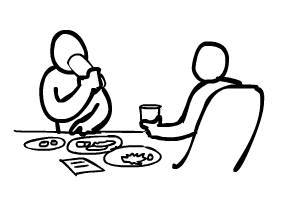Why
It doesn't matter if I'm teaching a class or coaching a team. When the moment comes, I need a quick way for a team to come to a decision. Why should the team decide and not me? From the seven standard leadership styles, I see consensus as the most appropriate for an empowered team. If the team is not empowered, they are not an Agile team.
How
When a decision has to be made, ask the team to do a fist of five. All the team members raise one hand to vote with their five fingers (unless they've suffered an accident in shop class). I depicted in the Fist of Five Pictofigo drawing, member votes range from a fist to five fingers. The term fist to five and fist of five are interchangeable.
Explaining the Details
I see a fist as a blocker. This individual is in complete disagreement and further discussion is required.
One finger (preferably not the middle one) has minimal support to the request at hand. Again, discussion is required.
Two fingers. Not happy with the current proposal. Should discuss as a group to try and resolve disagreements.
Three fingers. Luke warm response. May go along if the rest of the group is voting three, four, or five.
Four fingers. Pretty much agree with the request. There is some apprehension but you can't expect everyone to be all in all the time.
Five fingers. Full support. They drank the Kool-Aid
Certainly, the success of this strategy is going to depend on the team employing it. There will be some who just like to hear themselves talk and will throw up a fist, one, or two every time. Hear them out! You'll also have those who don't like to commit to anything. They will generally put up three fingers. Whatever the outcomes, try to keep a strict timebox for discussions. Remember, this was to be a quick way for a team to come to a decision.
I would be curious to hear when you use fist of five, your successes, and your failures.
Image Source: Pictofigo



